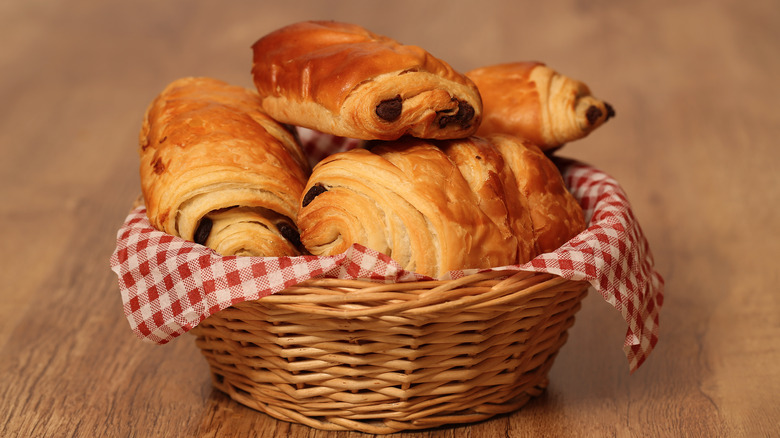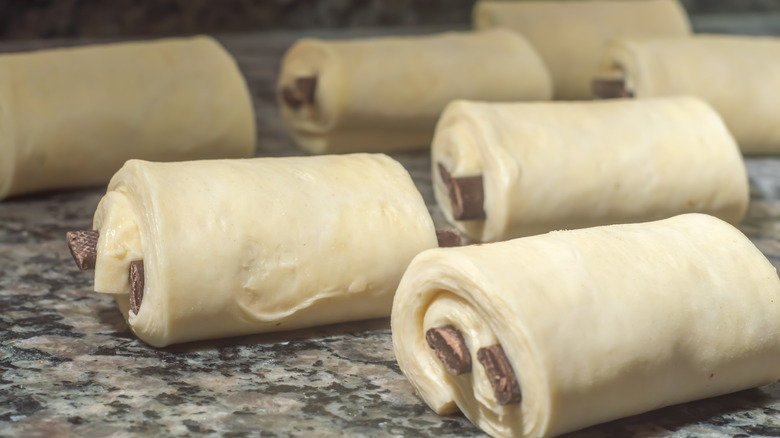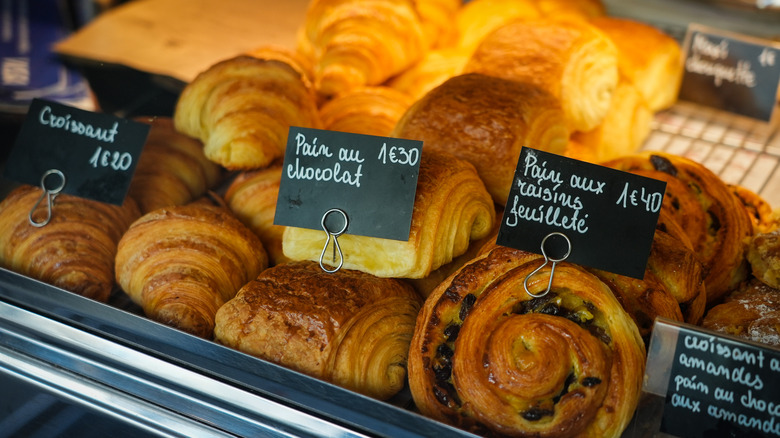The Easy Trick For Perfectly Balanced Pain Au Chocolat
Life is a balancing act, as the saying goes. Since chocolate plays a sometimes-outsized role in the human diet, at least for some folks, it stands to reason that delicious treats from the cacao tree of life need balancing from time to time, especially when it comes to pain au chocolat.
Translated from French to English, pain au chocolat means "chocolate bread." But it's not as simple as folding flakes of chocolate into bread dough or drizzling chocolate sauce over a freshly baked pastry. Even those unfamiliar with the French term have likely eaten a genuine pain au chocolate, otherwise known in the U.S. as a chocolate croissant, or in southwest France as a chocolatine. The rectangular shape differs from a standard croissant, but for a yummy reason: To hold those melty batons of chocolate nestled inside.
But even the biggest fans of pain au chocolat admit to a faint feeling of discontent when eating one — primarily because the chocolate disappears within the pastry, leaving you with more flaky cooked dough than soft, warm chocolate.
You may not have much control over chocolate distribution within a pain au chocolat purchased at a bakery or coffee shop, but you sure can balance your chocolate-craving taste buds when making your own at home. It's an easy upgrade and only takes a few extra seconds, plus an added chocolate baton — or two. Who's judging?
Not quite enough chocolate
Some chefs use a chocolate spread to make pain au chocolat, which may be easier to control chocolate placement before cooking. But it lacks the authenticity, pure undiluted chocolate taste, and the mouthfeel of rich, thick chocolate chunks. Traditional French pain au chocolat instead employ thin, long, and luscious sticks of dark or semi-sweet chocolate known as batons, specially designed for this use.
Pain au chocolate batons contain a smaller amount of cocoa butter than standard chocolates, which helps prevent burning in the oven, and come pre-cut to the standard size of the pastries.
Now comes the balancing trick. When making pain au chocolat pastries, many bakers use a single chocolate baton, placed on the edge of the flattened pastry dough and rolled into the center before cooking. Others employ two baton sticks, placed on each end of the dough and likewise rolled into the rectangular shape of the dough.
But there's a third option — a simple method for getting strategic disbursement of chocolate and the most cocoa-endowed goodness in every bite. The tip comes by way of baker Haris Car of Car Artisan Chocolate in Los Angeles, as shared with Eater.
Finding the ultimate chocolate-to-dough ratio
The chocolate balancing trick, Haris Car explained to Eater, all comes down to numbers — three batons instead of two — and placement. Imagine a long strip of flattened uncooked pastry dough, rolled out on the countertop. On one end, you place a chocolate baton across one edge, and a second baton across the opposite edge. Whereas most bakers would then roll the two baton-laden dough edges toward the center to create the ready-to-bake croissant, Car makes a small yet significant alteration: He slips an extra baton in the center of the strip of dough before rolling the two edges toward the center, coming to rest at the third center baton. Voila! A perfect chocolate-to-dough ratio that, when baked, gives three sticks of soft, warm chocolate evenly distributed within the dough — and a touch of chocolate in every bite.
If you're a home chef without oodles of extra kitchen time, you can try the same technique using pre-formed frozen croissant dough sheets. After defrosting and before rolling the flat pieces of dough into the croissant shape, place three pain au chocolat batons on the two edges and center, then roll your way to flaky goodness straight from your own oven.


